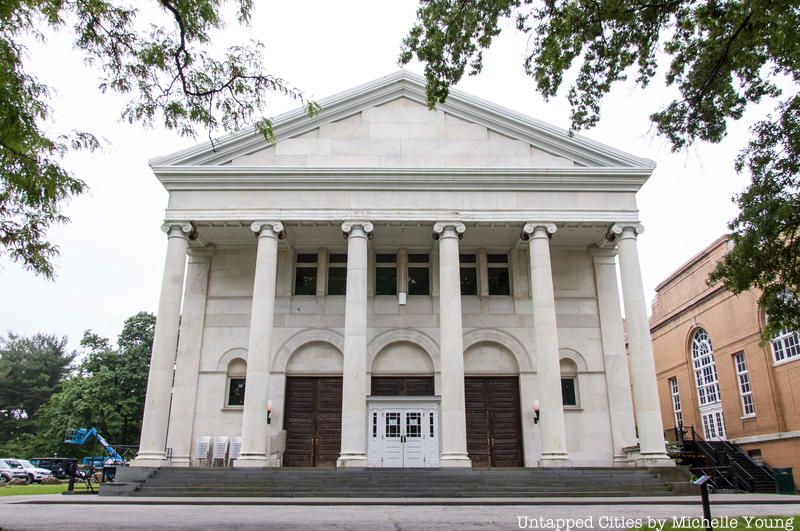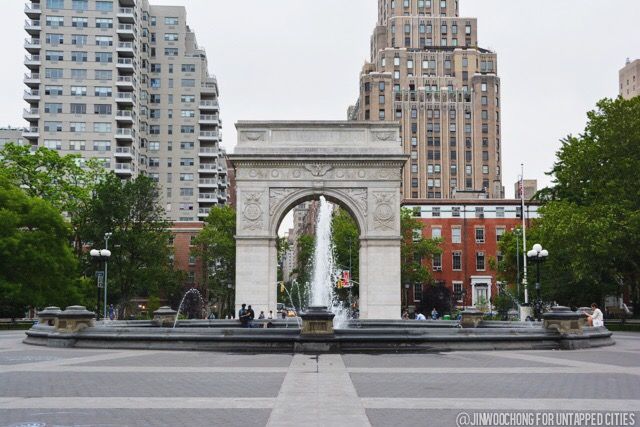Last-Minute NYC Holiday Gift Guide 🎁
We’ve created a holiday gift guide with presents for the intrepid New Yorker that should arrive just in time—


Performer David Bowie, a longtime resident of New York City, passed away on Sunday after an 18-month battle with cancer. Born in London in 1947, Bowie calls New York City the place he “had fantasized over since my teens.” In a look back, here are 5 iconic Bowie moments and locations which show his passion for New York as a city, as well as tributes to him following his death.
After two decades of pioneering music working with people as varied as Luther Vandross, John Lennon and Iggy Pop, Bowie debuted on Broadway in the title role of The Elephant Man, playing at the Booth Theatre on 45th Street. The year was 1980, and Bowie’s song “Ashes to Ashes” was at number one on the charts in the United Kingdom.
Without makeup or prosthetics, Bowie would perform the role 157 times over the course of three months to critical acclaim. The play is based on the real life story of Joseph Merrick, known in the Victorian era for his extreme body deformities. Bowie, in an interview with French TV channel TF1 said, “It never occurred to me to even consider trying to work in the realm of straight dramatic theater. I didn’t think I was qualified, nor that I had any particularly masterful technique which would put me anywhere near a stage in a credible fashion, but he had the audacity of courage or however you might view it to put me in that position. And I met the challenge, as I am of that nature to. Tend to leap into things without really thinking, and I accepted.”
The New York Times said Bowie’s performance was “splendid.” Clive Barnes at The New York Post praised the performance as “one of the greatest acting performances” he had seen in years. The Los Angeles Times called Bowie a “born actor.”
In the TF1 interview, Bowie credits Lindsay Kemp Mime Company with enabling the realistic and believable physical performance in The Elephant Man. Bowie’s New York Times obituary also describes Lindsay Kemp as a “lasting influence on Mr. Bowie, focusing his interest in movement and artifice.”

Photo courtesy Spotify
In true New York City fashion, David Bowie took over the Broadway-Lafayette and Bleecker Street subway stops in 2018, which are few blocks from where he lived. A collaboration between Spotify and The Brooklyn Museum, the stations have been covered in Bowie-themed subway ads, images of fan-made works and wall-sized depictions of pieces that were on display at the museum’s David Bowie Is exhibition.
The underground experience included limited edition MetroCards that displayed one of five Bowie personas including Ziggy Stardust, Aladdin Sane, and Thin White Duke. In 2019, on the anniversary of Bowie’s death, a guerrilla takeover of the Broadway-Lafayette subway station entrance marked four years after his death.
On October 20, 2001, a little over a month after the 9/11 attacks at the World Trade Center, Paul McCartney organizes the Concert for New York at Madison Square Garden to honor the first responders, victims of the attacks, and those continuing to work on the site. Bowie opened with Paul Simon’s “America,” followed by his own song “Heroes,” which he dedicated to his local New York Fire Department company. The star-studded affair included performances by Mick Jagger, Keith Richards, Jay Z, The Who, Bon Jovi, James Taylor and many more, with celebrity introductions by the likes of Bill Clinton, Natalie Portman, Robert De Niro and more.

Snug Harbor Music Hall
In 2002’s “New York City Marathon Tour,” (also called the NYC Bowie-athon), Bowie played a show in each of New York City’s boroughs following the order of the New York City Marathon and allowed a photographer to follow him on tour for the first time in 15 years. In the accompanying photo book David Bowie: Live In New York with photos by Myriam Santos-Kayda, Bowie gives his reasons for doing the tour: “The last time I came through the Northeast it was on the Area 2 Tour. We played in amphitheaters, which are usually a good distance from the major cities. Marathon courses are strategically planned to bring the runners to the streets. I would like to repay the fans that traveled so far to see me by bringing my show to them. But most importantly, I could get home from all the gigs on roller skates.”
The venues were: The Music Hall at Snug Harbor, St. Ann’s Warehouse in Brooklyn, the Queens College Golden Center, Jimmy’s Bronx Cafe, and the Beacon Theatre on Manhattan’s Upper West Side.
Bowie’s last album, Blackstar, was released on January 8, 2016, which he worked on while battling cancer. Lazarus, also the title of a song on Blackstar, is an Off-Broadway musical at the New York Theatre Workshop that Bowie collaborated on with Ivo Van Hove, which opened in November 18, 2015 and will have its last performance on January 20th. The New York Times wrote just before the show opening that Bowie “conceived the show as a sort of sequel to The Man Who Fell to Earth the 1963 Walter Tevis novel that inspired the 1976 Nicolas Roeg film, in which Mr. Bowie starred as Thomas Newton, a louche, orange-haired extraterrestrial.
The video for Lazarus, above, is directed by Johan Renck, who says on on Bowie’s website:
“One could only dream about collaborating with a mind like that; let alone twice. Intuitive, playful, mysterious and profound… I have no desire to do any more videos knowing the process never ever gets as formidable and fulfilling as this was. I’ve basically touched the sun.”
The opening lines of the song, with Bowie in what appears to be a hospital bed, are “Look up here, I’m in heaven.” Later, he sings “By the time I got to New York, I was living like a king.” Hauntingly it concludes:
This way or no way, You know, I’ll be free
Just like that bluebird, Now ain’t that just like me
Oh I’ll be free, Just like that bluebird
Oh I’ll be free, Ain’t that just like me.

Untapped Cities contributor, Laurie Gwen Shapiro, came across a curious find on 42 Bond Street: a David Bowie-themed gate in front of an otherwise nondescript townhouse. “… [it] has bits of David Bowie’s face and you can only see him if you are walking and from a certain angle,” she tells us after spotting the installation. Each side of the gate features a different image that’s been cut into strips and split up among the rungs. According to Shapiro, they’ve been there since Bowie’s death.

Though Bowie lived at 285 Lafayette Street, where tributes and memorials have been going up, he had reportedly said that his favorite place in New York City was Washington Square Park.
There’s also a great scene in the movie Francis Ha, with the soundtrack of David Bowie’s Modern Love, inspired by a scene from Leos Carax’s Mauves Sang (Bad Blood) where Denis Lavant does runs and dances to the same song.
Next, check out this interactive music map of song references in New York City.
Subscribe to our newsletter